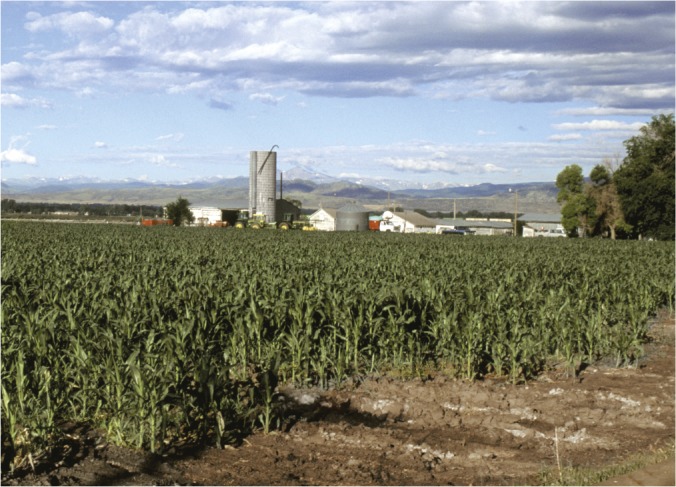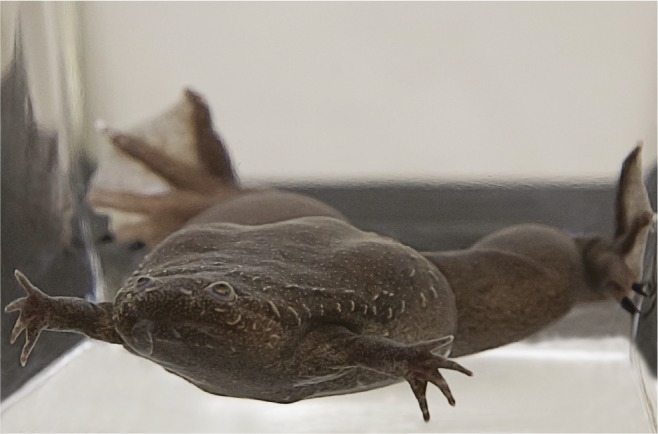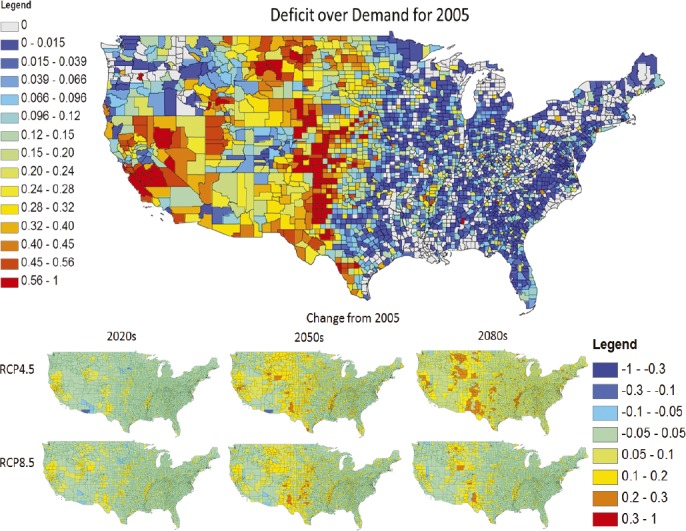Greenhouse gas emissions in the Great Plains

Corn production in Colorado. Image courtesy of Scott Bauer (US Department of Agriculture).
The US Great Plains is a globally important agricultural production center, and consequently a significant source of greenhouse gas (GHG) emissions. William Parton et al. (pp. E4681–E4688) combined historical records with ecosystem models to estimate annual GHG fluxes from all agricultural sources in the Great Plains from 1870 to 2000. These sources include crop cultivation, livestock, irrigation, fertilizer, and tractor use. Carbon released from the soil during plow-out of native grasslands was the largest source of GHG emissions prior to 1930. Soil carbon emissions declined steadily over the next several decades, resulting in net sequestration of carbon in the soil after 1970. However, nitrous oxide emissions from fertilizer continued to increase. Methane emissions from livestock increased steadily throughout the 20th century, making livestock the dominant source of GHG emissions today. Fuel consumption for tractors, irrigation, and fertilizer production has also been an important source of GHG emissions since the 1950s. Climatic variation influences emissions, with increased carbon sequestration during cool, wet years and increased emissions during hot, dry years. The authors estimate that implementing agricultural best-management practices, particularly no-till cultivation, could reduce GHG emissions by more than 100% with greater than 75% farmer participation rates. — B.D.
Social dynamics in bacteria

Cultures of a producer of pyoverdine (Left) and a pale nonproducer (Right) of P. aeruginosa isolates. Image courtesy of Adin Ross-Gillespie (University of Zürich, Zürich).
Environmental bacteria that cause opportunistic infections evolve to adapt to human hosts, but cooperation and competition among bacterial cells may also play a role in bacterial evolution. To distinguish host-driven from socially-driven evolution, Sandra Andersen et al. (pp. 10756–10761) studied Pseudomonas aeruginosa, a bacterium that colonizes the lungs of patients with cystic fibrosis (CF). P. aeruginosa produces both the soluble iron chelator pyoverdine and a pyoverdine receptor. In laboratory dishes, pyoverdine serves as a public good, hence pyoverdine nonproducers can coopt the pyoverdine from producers. Though the pyoverdine system can be lost in response to altered iron availability within the host, the authors predicted that evolution of coopting bacteria could be detected in vivo by a preferential loss of the ability to produce pyoverdine but not its receptor. The authors measured pyoverdine production in 529 P. aeruginosa isolates taken from 60 CF patients. During the first 10 years of infection, the proportion of pyoverdine nonproducers increased over time, with mutations targeting biosynthesis of both pyoverdine and its receptor. However, cells that lost the ability to produce pyoverdine were far more likely to retain production of the receptor if coinfecting isolates produced pyoverdine. The findings demonstrate that social interactions contribute to microbial evolution in vivo, according to the authors. — C.B.
Tooth wear and diet of fossil animals
Paleontologists routinely analyze tooth wear to reconstruct the diet of fossil vertebrates, but whether damage to enamel surfaces reveals more about the habitat than the diet remains unclear. For example, some evidence suggests that abrasives naturally found in plants are too soft to cause tooth wear, which may be caused instead by soil-derived quartz grit deposited on food. Jing Xia et al. (pp. 10669–10672) tested whether tooth wear could be caused by particles softer than enamel, such as aluminum and brass. The authors mounted tiny aluminum, brass, and silicon dioxide (SiO2) spheres onto tips attached to instruments that dragged the spheres across enamel surfaces. All three spheres produced scratch grooves on the surfaces and removed enamel chips in the process. The debris was washed off with water, demonstrating that the spheres caused tissue loss rather than deformation. When the SiO2 sphere was dragged across the enamel surface under conditions mimicking chewing, enamel crystallites separated from the surface, suggesting that softer particles can remove tissue if the contact pressure is sufficient to break the bonds holding enamel together. According to the authors, the findings validate the use of tooth wear for understanding the diet of fossil animals and for reconstructing species from the earliest vertebrates to human ancestors. — J.W.
Sex chromosomes in Xenopus tropicalis

Xenopus tropicalis female. Image courtesy of Antonio Carrasco Lombardo and Amparo Carrasco Castillo (photographers).
The amphibian Xenopus tropicalis—a model organism for many biological studies—lacks the only sex-determining gene found so far in amphibians, and its sex chromosome system is still unclear. Álvaro Roco et al. (pp. E4752–E4761) used a combination of genetic approaches to describe the sex chromosome system of X. tropicalis. The authors detected three types of sex chromosomes in X. tropicalis: Y, W, and Z. The chromosomes give rise to three types of males, YZ, YW, and ZZ, and two types of females, ZW and WW. In most vertebrate species either the male or the female is heterogametic, possessing two different types of sex chromosomes. Species with both male and female heterogametic individuals, such as X. tropicalis, are rare due to the possibility of some combinations of parental sex chromosomes producing offspring with sex ratios different from 1:1. In X. tropicalis the different parental combinations result in six different classes of offspring with 0:1, 3:1, and 1:1 ratios of males to females. According to the authors, the study has implications for the use of X. tropicalis as a model system and suggests that using strains with defined sex chromosomes is critical for genetic or ecotoxicology studies that rely on interpreting the gender of the offspring. — S.R.
Epigenetic mechanisms and T-cell coreceptors
T-cell expression of CC chemokine receptor 5 (CCR5), the major HIV-1 coreceptor, is a key determinant of AIDS susceptibility. Using multiple study populations, German Gornalusse et al. (pp. E4762–E4771) found that the DNA methylation status of noncoding DNA regions, such as promoters and introns, within CCR5 called cis-regulatory regions (cis-regions) was inversely correlated with T-cell CCR5 levels. As a result, constitutive differences in cis-region DNA methylation content between different types of T cells or between individual T cells were associated with differences in CCR5 levels between different T cell types or between individual T cells, respectively. Relatively small differences in methylation content were associated with large effects on T-cell CCR5 levels. HIV-associated or in vitro-induced activation of T cells resulted in demethylation of CCR5 cis-regions. Genetic variations in the CCR5 cis-regions that are associated with high or low AIDS susceptibility were associated with increased or decreased sensitivity to activation-induced demethylation, respectively. The findings uncover an epigenetic mechanism that influences CCR5 expression on T cells. Genetically determined differences in sensitivity to HIV-associated demethylation of CCR5 cis-regions may serve as a mechanism for the wide interindividual variation in AIDS susceptibility and disease outcomes, according to the authors. — S.R.
Water stress under carbon mitigation scenarios

County-scale map of average annual water deficits in the United States. Warm colors represent increasing proportions of water demands.
Because global climate change is projected to increase evapotranspiration, drought, and other water stresses, carbon emission mitigation has been seen as a pathway to ease water stress. Mohamad Hejazi et al. (pp. 10635–10640) constructed a model at a fine spatial scale that integrates regional climate models as well as models of human activity to predict changes in water stress under two climate scenarios. The authors projected water deficits, defined as events in which surface water was insufficient to meet water needs, and further identified water deficit hotspots, in which the demand for water was more than 10% greater than the amount provided by surface water. The authors found that the severity of water deficit in hotspots was greater under an emissions mitigation scenario than under a business-as-usual scenario. Both supply of and demand for water increased under an emissions mitigation scenario, but the authors found that demand may outpace supply due to possible population growth, demand for food, and irrigation of bioenergy crops to meet energy needs. The results suggest that high-resolution human and natural systems models may identify previously unrecognized implications of climate policy measures, and that understanding the effect of such measures on water usage may help achieve both carbon emission and water stress mitigation goals, according to the authors. — P.G.


